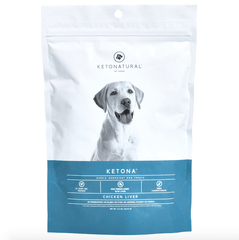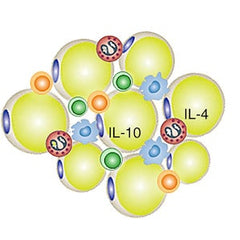Save Money, Save Your Dog.
Join Our Email List For Discounted Pricing and a Free Guide to the Science of Keto Dog Food.
At KNPF we beat our anti-body-fat drum loud and proud. Body fat kills dogs. And we want our dogs to live for a long time. So we’re against body fat.
The purpose of this article is to explain one of the reasons why body fat is so dangerous, not only for dogs but for other animals as well. Specifically, we’re going to look at the tendency of body fat to induce harmful systemic inflammation through the secretion of adipokines. I promise that the explanation will be shorter, simpler, and less technical than that overview makes it sound (although I still expect that will be the last sentence that many of you will actually read – bye-bye, wimps!).
(Now, for those of you still with us…)
Few people recognize that body fat is actually an active organ, not just a passive source of fuel for the body’s metabolic processes. As University of Liverpool veterinarian Alexander J. German and his colleagues explained in their nice overview of this topic, fat actually communicates with other bodily organs – chiefly, the brain – by actively secreting hormones and protein factors collectively called adipokines. These substances are the vehicles by which fat sends messages to other parts of the body for the purpose of triggering physical responses from those other organs.
Adipokines have been shown to inhibit, induce, or otherwise influence an array of bodily systems and functions, including glucose homeostasis, inflammation and immunity, vasculature, and even neurotrophic functions.
Today we’re focusing on inflammation. The process of inflammation essentially is the body’s “first response” to injury, pain, illness, and stress. It comes in two flavors -- acute and chronic/systemic – and the distinction between the two is critical.
Acute inflammation is observable as the increased blood flow (i.e., redness), fluid buildup (i.e., swelling), and loss of function (i.e., pain) that results when you suffer a localized injury, like a sprained knee or a bump on the head. Acute inflammation facilitates the healing of acute injuries, both by flooding the injury site with tissue repair agents like leukocytes and by discouraging re-injury. It’s a tremendously useful and completely intuitive function -- if you were building from the ground up a body for an organism, you’d surely include an acute inflammatory response system not unlike the one operating in your own body. In short, it’s great.
But systemic inflammation is another story altogether.
When inflammation becomes chronic and systemic, the triggering hormonal switch just stays in the “on” position constantly, albeit at a lower volume. So a process that’s supposed to ramp-up only in the presence of an acute injury is instead running all the time. If you think about it for a minute, it’s clear that this represents a malfunctioning of the inflammatory response system -- the response is supposed to be quick and site-specific (think of the near-instantaneous swelling of a twisted ankle), not never-ending.
And it’s a bad thing (a really bad thing) to have the inflammatory system running constantly. Want proof? No problem. Studies have linked chronic inflammation with chronic depression, cancers, chronic obstructive pulmonary disease, and heart disease, just to name a few. As you can probably imagine, it also decreases the sensitivity of the inflammatory response system to acute injuries.
So what could give rise to such an ugly systemic malfunction? You guessed it---body fat. As I noted back at the start of this essay, body fat secretes adipokines and many types of adipokines have been shown to trigger the cascade of inflammatory responses (if you want more technical detail on specific factors and concentrations that give rise to inflammatory responses, a good place to start would be the study by German and his colleagues that I mentioned above). That’s why obesity is so closely linked with chronic inflammation, because the large quantities of fat in the bodies of obese people and dogs are constantly producing large quantities of inflammation-inducing adipokines. And this ensures that the inflammatory switch stays in the “on” position full-time.
In other words, if you want to help your dog avoid chronic inflammation and all of its harmful consequences, you need to help your dog minimize the quantity of fat in its body. The logical chain goes something like this: (1) reduce body fat, (2) reduce inflammation-inducing adipokines, (3) reduce systemic inflammation, (4) reduce harmful side-effects of chronic inflammation, so to (5) help your dog live a longer, happier, and healthier life. It’s that easy.
That’s it for today folks. Have a great weekend.
Cheers,
- Coach Dan


Related Articles
How Much Does The Farmer’s Dog Really Cost?
5 Signs and Symptoms That Your Dog May Have Diabetes
Learning to Take Pleasure In Being Your Dog's Play Buddy-Drill Sargeant
Dogs, Dog Food and Dogma - A Book About America's Pet Obesity Epidemic
Browse Articles By Category